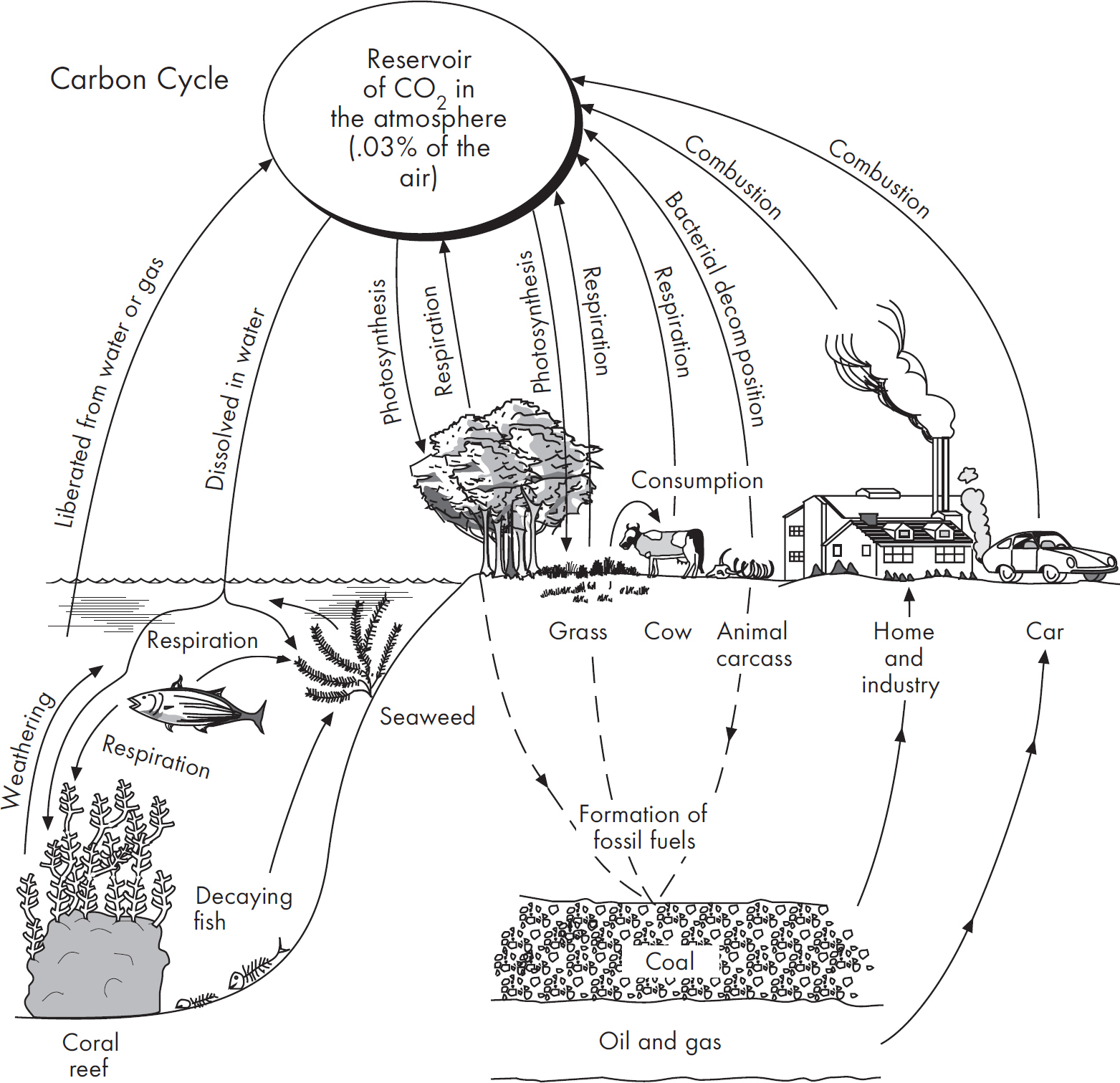
In the preceding chapters, we looked at individual organisms and the ways they solve life’s many problems: acquiring nutrition, reproducing, and so on. Now let’s turn to how organisms deal with their environments.
Organisms are constantly interacting with their environments. As the environmental stimuli change so must the behavior of the organism. This is important for gathering the most energy while using the least energy and reproducing as efficiently as possible.
A general rule is that larger animals have a slower metabolic rate per unit mass than smaller animals. In other words, if you took the same amount of tissue from a small animal and a large animal, the tissue from the small animal would have a higher rate of metabolism.
When animals have excess energy, they grow and store energy. When they are deficient, then they use up their stores and lose mass and eventually die.
Body temperature is one way that animals must respond to their environment. Endotherms are animals that generate their own body heat through metabolism. Ectotherms lack an internal mechanism to control body temperature. Instead they regulate their temperature behaviorally by seeking out cool or warm places. One example is a lizard on a warm rock.
A big part of behavior is communication. This is important between members of the same species to coordinate group behavior. Animals use visual, auditory, chemical, tactile, and electrical signals to indicate dominance, find food, establish territory, and reproduce successfully. Communication is also important between members of different species that are engaged in cooperative behaviors.
Some animals behave in a programmed way to specific stimuli, while others behave according to some type of learning. We humans can do both. For the AP Biology Exam, you’ll have to know a little about these different types of behavior—that is, how organisms cope with their environments.
Instinct is an inborn, unlearned behavior. Sometimes the instinctive behavior is triggered by environmental signals called releasers. The releaser is usually a small part of the environment that is perceived. For example, when a male European robin sees another male robin, the sight of a tuft of red feathers on the male is a releaser that triggers fighting behavior. In fact, because instinct underlies all other behavior, it can be thought of as the circuitry that guides behavior.
For example, hive insects, such as bees and termites, never learn their roles; they are born knowing them. On the basis of this inborn knowledge, or instinct, they carry out all their other behaviors: a worker carries out “worker tasks,” a drone “drone tasks,” and a queen “queen tasks.” Another example of instinct is the “dance” of the honey bee, which is used to communicate the location of food to other members of the beehive.
There are other types of instinct that last for only a part of an animal’s life and are gradually replaced by “learned” behavior. For example, human infants are born with an ability to suck from a nipple. If it were not for this instinctual behavior, the infant would starve. Ultimately, however, the infant will move beyond this instinct and learn to feed itself. What exactly, then, is instinct?
For our purposes:
Instinct is the inherited “circuitry” that directs and guides behavior.
Another form of behavior is learning. Learning refers to a change in a behavior brought about by an experience (which is what you’re doing this very moment). Animals learn in a number of ways.
Have you ever seen a group of goslings waddling along after their mother? How is it that they recognize her? Well, the mother arrives and gives out a call that the goslings recognize. The goslings, hearing the call, know that this is their mother, and follow her around until they are big enough to head out on their own.
Now imagine the same goslings, newly hatched. If the mother is absent, they will accept the first moving object they see as their mother. This process is known as imprinting.
Animals undergo imprinting within a few days after birth in order to recognize members of their own species. While there are different types of imprinting, including parent, sexual, and song imprinting, they all occur during a critical period—a window of time when the animal is sensitive to certain aspects of the environment.
Remember:
Imprinting is a form of learning that occurs during a brief period of time, usually early in an organism’s life.
Habituation is another form of learning. It occurs when an animal learns not to respond to a stimulus. For example, if an animal encounters a stimulus over and over again without any consequences, the response to it will gradually lessen and may altogether disappear. For example, if a certain hallway always smells weird, you will notice at first but eventually learn not to notice it. The basic response (smell) has not been lost, merely modified by learning. If you walk down a new hallway and it has the same weird smell, you will notice it.
There are other instinctual behaviors that occur in both animals and plants. One such behavior deals with time. Have you ever wondered how roosters always know when to start crowing? The first thought that comes to mind is that they’ve caught a glimpse of the sun. Yet many crow even before the sun has risen.
Roosters do have internal alarm clocks. Plants have them as well. These internal clocks, or cycles, are known as circadian rhythms. Circadian sounds like the word circle, just like these rhythms have a circular nature.
Watch out though: seasonal changes, like the loss of leaves by deciduous trees or the hibernation of mammals, are not examples of circadian rhythms. Circadian refers only to daily rhythms. Need a mnemonic? Just think how bad your jet lag would be after a trip around the world. In other words: circling the globe screws up your circadian rhythm.
The Science Behind Your Jet Lag
If you’ve ever flown overseas, you know all about circadian rhythms. They’re the cause of jet lag. Our bodies tell us it’s one time, while our watches tell us it’s another. The sun may be up, but our body’s internal clock is crying, “Sleep!” This sense of time is purely instinctual: you don’t need to know how to tell time in order to feel jet lag.
Some animals use signals as a way of communicating with members of their species. These signals, which can be chemical, visual, electrical, or tactile, are often used to influence mating and social behavior.
Chemical signals are one of the most common forms of communication among animals. Pheromones, for instance, are chemical signals between members of the same species that stimulate olfactory receptors and ultimately affect behavior. For example, when female insects give off their pheromones, they attract males from great distances.
Visual signals also play an important role in the behavior observed among members of a species. For example, fireflies produce pulsed flashes that can be seen by other fireflies far away. The flashes are sexual displays that help male and female fireflies identify and locate each other in the dark.
Other animals use electrical channels to communicate. Some fish generate and receive weak electrical fields. Others use tactile signals and have mechanoreceptors in their skin to detect prey. For instance, cave-dwelling fishes use mechanoreceptors in their skin for communicating with other members and detecting prey.
Many animals are highly social species, and they interact with each other in complex ways. Social behaviors can help members of the species survive and reproduce more successfully. Several behavioral patterns for animal societies are summarized below:
Agonistic behavior is aggressive behavior that occurs as a result of competition for food or other resources. Animals will show aggression toward other members that tend to use the same resources. An example of agonistic behavior is fighting among competitors.
Dominance hierarchies (pecking orders) occur when members in a group have established which members are the most dominant. The more dominant male will often become the leader of the group and will usually have the best pickings of the food and females in the group. Once the dominance hierarchy is established, competition and tension within the group is reduced.
Territoriality is a common behavior when food and nesting sites are in short supply. Usually, the male of the species will establish and defend his territory (called a home range) within a group in order to protect important resources. This behavior is typically found among birds.
Altruistic behavior is defined as unselfish behavior that benefits another organism in the group at the individual’s expense because it advances the genes of the group. For example, when ground squirrels give warning calls to alert other squirrels of the presence of a predator, the calling squirrel puts itself at risk of being found by the predator.
Many organisms that coexist exhibit some type of symbiotic relationship. These include remoras, or “sucker fish,” which attach themselves to the backs of sharks, and lichen—the fuzzy, mold-like stuff that grows on rocks. Lichen appears to be one organism, when in fact it is two organisms—a fungus and a photosynthetic organism such as an alga or cyanobacterium—living in a complex symbiotic relationship.
Overall, there are three basic types of symbiotic relationships:
Mutualism—in which both organisms win (for example, the lichen components)
Commensalism—in which one organism lives off another with no harm to the host organism (for example, the remora)
Parasitism—in which the organism actually harms its host
There are many special types of relationships between multicellular organisms and unicellular organisms. One important example is bacteria living inside the guts of many mammals. We have a mutualistic relationship. Humans and other mammals provide the bacteria a nice home with nutrients, and they help us in many ways by breaking things down and helping us make things. It is also good that we are filled with “good” bacteria because otherwise we might be susceptible to dangerous pathogenic bacteria.
Plants have also evolved specific ways to respond to their environment. The plant behaviors covered on the AP Biology Exam are photoperiodism and tropisms. Plants flower in response to changes in the amount of daylight and darkness they receive. This is called photoperiodism. Although you’d think that plants bloom based on the amount of sunlight they receive, they actually flower according to the amount of uninterrupted darkness.
Plants need light. Notice that all the plants in your house tip toward the windows. This movement of plants toward the light is known as phototropism. As you know, plants generally grow up and down: the branches grow upward, while the roots grow downward into the soil, seeking water. This tendency to grow toward or away from the earth is called gravitropism. All of these tropisms are examples of behavior in plants.
A tropism is a turning in response to a stimulus.
There are three basic tropisms in plants. You can remember them because their prefixes represent the stimuli to which plants react:
Phototropism refers to the way plants respond to sunlight—for example, bending toward light.
Gravitropism refers to the way plants respond to gravity. Stems exhibit negative gravitropism (they grow up, away from the pull of gravity), whereas roots exhibit positive gravitropism (they grow downward into the earth).
Thigmotropism refers to the way plants respond to touch. For example, ivy grows around a post or trellis.
These responses are initiated by hormones. The major plant hormones you need to know belong to a class called auxins. Auxins serve many functions in plants. They can promote growth on one side of the plant. For example, in phototropism, the side of the plant that faces away from the sunlight grows faster, thanks to the plant’s auxins, making the plant bend toward the light.
Generally speaking, auxins are in the tip of the plant, because this is where most growth occurs. Auxins are also involved in cell elongation and fruit development.
Other plant hormones that regulate the growth and development of plants are gibberellins, cytokinins, ethylenes, and abscisic acid. Here’s a summary of the functions of plant hormones:
|
FUNCTIONS OF PLANT HORMONES |
|
|
Hormone |
Function |
|
Gibberellins |
Promote stem elongation, especially in dwarf plants |
|
Cytokinins |
Promote cell division and differention |
|
Ethylene |
Induces leaf abscission and promotes fruit ripening |
|
Abscisic acid |
Inhibits leaf abscission and promotes bud and seed dormancy |
|
Auxins |
Promote plant growth and phototropism |
We’ve already discussed how important cell communication is to organisms, and plants are no exception. These hormones play an important role in allowing plants to grow, develop, survive, and adapt to environmental cues. They act as signaling molecules, bind to receptors, and function using signal transduction. These cell communication pathways are similar to what happens in animal cells.
The study of interactions between living things and their environments is known as ecology. We’ve spent most of our time discussing individual organisms. However, in the real world, organisms are in constant interaction with other organisms and the environment. The best way for us to understand the various levels of ecology is to progress from the big picture, the biosphere, down to the smallest ecological unit, the population.
There is a hierarchy within the world of ecology. Each of the following terms represents a different level of ecological interaction:
Biosphere: The entire part of the earth where living things exist. This includes soil, water, light, and air. In comparison to the overall mass of the earth, the biosphere is relatively small. If you think of the earth as a basketball, the biosphere is equivalent to a coat of paint over its surface
Ecosystem: The interaction of living and nonliving things
Community: A group of populations interacting in the same area
Population: A group of individuals that belong to the same species and that are interbreeding
The biosphere can be divided into large regions called biomes. Biomes are massive areas that are classified mostly on the basis of their climates and plant life. Because of different climates and terrains on the earth, the distribution of living organisms varies.
Remember that biomes tend to be arranged along particular latitudes. For instance, if you hiked from Alaska to Kansas, you would pass through the following biomes: tundra, taiga, temperate deciduous forests, and grasslands.
Ecosystems are self-contained regions that include both living and nonliving factors. For example, a lake, its surrounding forest, the atmosphere above it, and all the organisms that live in or feed off the lake would be considered an ecosystem. Living factors are called biotic factors and nonliving factors are called abiotic factors. Abiotic factors include water, humidity, temperature, soil/atmosphere composition, light, and radiation. As you probably know, there is an exchange of materials between the components of an ecosystem.
Take a look at the flow of carbon through a typical ecosystem.

You’ll notice how carbon is recycled throughout the ecosystem—this is called the carbon cycle. In other words, carbon flows through ecosystems. There are also cycles for nitrogen and water. The interactions between the biotic and the abiotic factors are crucial for balance of the ecosystem.
The next smaller level is the community. A community refers to a group of interacting plants and animals that show some degree of interdependence. For instance, you, your dog, and the fleas on your dog are all members of the same community.
Each organism has its own niche—its position or function in a community. When two organisms occupy the same niche, they will compete for the resources within that niche. If a species can occupy an unoccupied niche, it will usually thrive without competition. These connections are shown in the food chain. A food chain describes the way different organisms depend on one another for food. There are basically four levels to the food chain: producers, primary consumers, secondary consumers, and tertiary consumers.
Producers, or autotrophs, have all of the raw building blocks to make their own food. From water and the gases that abound in the atmosphere and with the aid of the sun’s energy, photosynthetic autotrophs convert light energy to chemical energy. They accomplish this through photosynthesis.
Primary productivity is the rate at which autotrophs convert light energy into chemical energy in an ecosystem. There are two types of primary productivity:
The gross productivity just from photosynthesis cannot be measured because cell respiration is occurring at the same time.
Net productivity measures only organic materials that are left over after photosynthetic organisms have taken care of their own cellular energy needs. This is calculated by measuring oxygen production in the light, when both photosynthesis and cell respiration are occurring. The equation for this relationship is listed on the Biology Equations and Formulas sheet.
Autotrophs produce all of the available food. They make up the first trophic (feeding) level. They also possess the highest biomass (the total weight of all the organisms in an area) and the greatest numbers. Did you know that plants make up about 99 percent of the earth’s total biomass?
Consumers, or heterotrophs, are forced to find their energy sources in the outside world. Basically, heterotrophs digest the carbohydrates, lipids, proteins, and nucleic acids of their prey into carbon, hydrogen, oxygen, etc. and use these molecules to make organic substances.
The bottom line is that heterotrophs, or consumers, get their energy from the things they consume.
Primary consumers are organisms that directly feed on producers. A good example is a cow. These organisms are also known as herbivores. They make up the second trophic level.
The next level consists of organisms that feed on primary consumers. They are the secondary consumers, and they make up the third trophic level. Above these are tertiary consumers.
All organisms at some point must finally yield to decomposers. Decomposers are the organisms that break down organic matter into simple products. Generally, fungi and bacteria are the decomposers. They serve as the “garbage collectors” in our environment.
Producers make their own food.
Primary consumers (herbivores) eat producers.
Secondary consumers (carnivores and omnivores) eat producers and primary consumers.
Tertiary consumers eat all of the above.
Decomposers break things down.
Sometimes one organism is particularly important to an ecosystem. Maybe it is the only producer or maybe it is the only thing that keeps a particularly deadly predator in check. Important species like this are called keystone species. If a keystone species is removed from the ecosystem, the whole balance can be undone very quickly.
In a food chain, only about 10 percent of energy is transferred from one level to the next—this is called the 10% rule. The other 90 percent is used for things like respiration, digestion, reproduction, running away from predators—in other words, it’s used to power the organism doing the eating! This energy is eventually changed into heat energy. As a level, producers have the most energy in an ecosystem; the primary consumers have less energy than producers; secondary consumers have less energy than the primary consumers; and tertiary consumers have the least energy of all.
The energy flow, biomass, and numbers of members within an ecosystem can be represented in an ecological pyramid. Organisms that are higher up on the pyramid have less biomass and energy, and they are fewer in number.
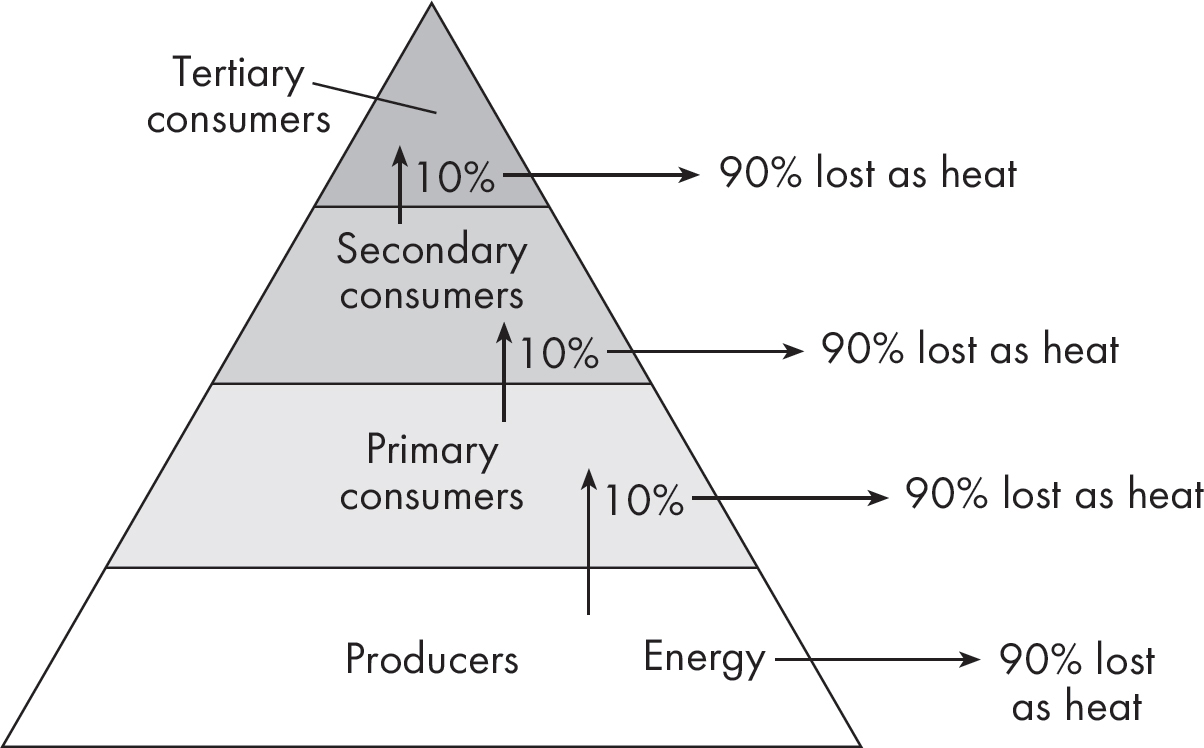
The downside of food pyramids is that when consumers at the top eat something beneath them, it is like they are eating that thing AND the thing that thing ate AND and the thing that thing ate, etc. So, if there is a toxin in the environment, the consumers at the top are getting the most of it because it becomes more concentrated at each level.
Toxins in an ecosystem are more concentrated and thus more dangerous for animals further up the pyramid.
This simply means that if a toxin is introduced into an ecosystem, the animals most likely to be affected are those at the top of the pyramid. This occurs because of the increasing concentration of such toxins. The classic example of this phenomenon is DDT, an insecticide initially used to kill mosquitoes. Although the large-scale spraying of DDT resulted in a decrease in the mosquito population, it also wound up killing off ospreys.
Ospreys are aquatic birds of prey whose diet consists primarily of fish. The fish that ospreys consumed had, in turn, been feeding on contaminated insects (bioaccumulation). Because fish eat thousands of insects, and ospreys hundreds of fish, the toxins grew increasingly concentrated (biomagnification). Though the insecticide seemed harmless enough, it resulted in the near extinction of certain osprey populations. What no one knew was that in sufficient concentrations, DDT weakened the eggshells of ospreys. Consequently, eggs broke before they could hatch, killing the unborn ospreys.
Such environmental tragedies still occur. All ecosystems, small or great, are intricately woven, and any change in one level invariably results in major changes at all the other levels.
Ecosystems are never exactly stable, existing in a precarious balance. Many things can disrupt the balance. If the biomass at any level changes, this will affect the surrounding levels and spread throughout the ecosystem. Geological changes, weather changes, new species, diseases, lack of resources, new resources, and many other things can disrupt the balance.
A diverse community is more likely to withstand extreme events. The Simpson’s Diversity Index is a measure of the diversity of a community.
Simpson’s Diversity Index
Diversity Index = 1 Σ 
n = the total number of organisms of a particular species
N = the total number of organisms of all species
Population ecology is the study of how populations change. Whether these changes are long-term or short-term, predictable or unpredictable, we’re talking about the growth and distribution patterns of a population.
When studying a population, you need to examine four things: the size (the total number of individuals), the density (the number of individuals per area), the distribution patterns (how individuals in a population are spread out), and the age structure.
For example, the graph below shows there is a high death rate among the young of oysters, but those that survive do well. On the other hand, there is a low death rate among the young of humans, but, after age 60, the death rate is high.
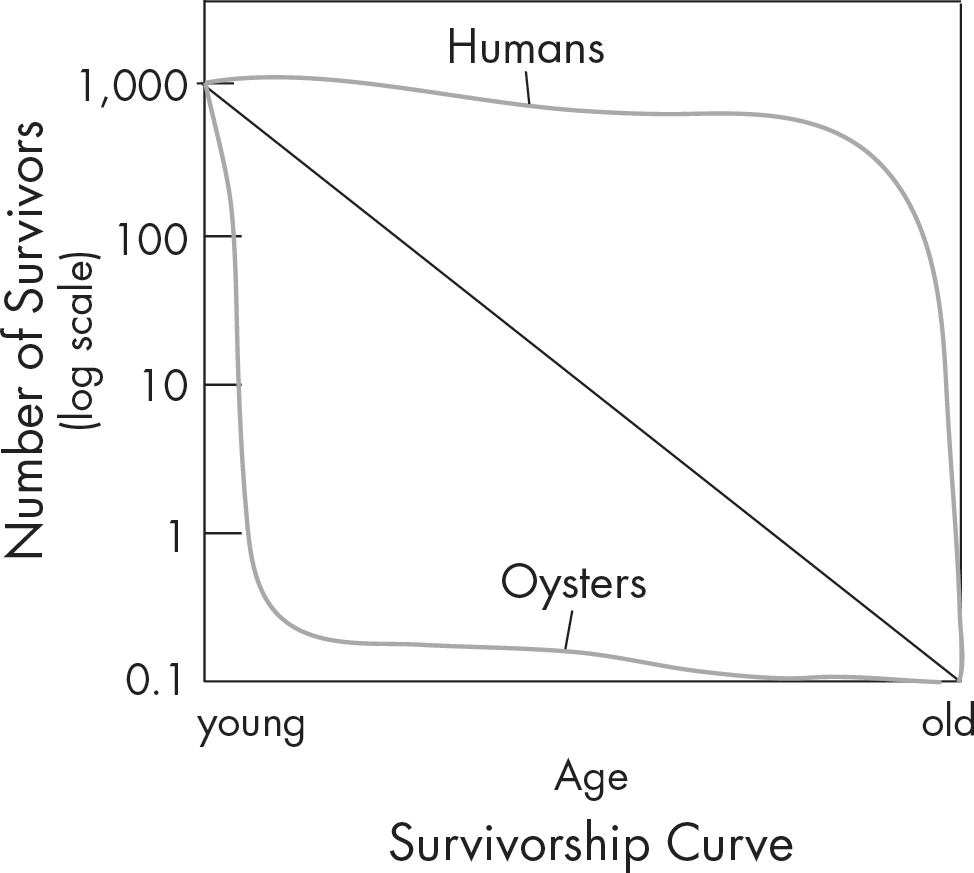
Population growth can be represented as the number of births minus the number of deaths divided by the size of the population.
r = (births – deaths)/N
(r is the reproductive rate, and N is the population size.)
Population growth can also be calculated in the following way:

Each population has a carrying capacity—the maximum number of individuals of a species that a habitat can support. Most populations, however, don’t reach their carrying capacity because they’re exposed to limiting factors.
One important factor is population density. The factors that limit a population are either density-independent or density-dependent. Density-independent factors affect the population, regardless of the density of the population. Some examples are severe storms and extreme climates. On the other hand, density-dependent factors are those with effects that depend on population density. Resource depletion, competition, and predation are all examples of density-dependent factors. In fact, these effects become even more intense as the population density increases.
The growth rates of populations also vary greatly. There are two types of growth: exponential growth and logistic growth. Equations for both are included on the AP Biology Equations and Formulas sheet. Exponential growth occurs when a population is in an ideal environment. Growth is unrestricted because there are lots of resources, space, and no disease or predation. Here’s an example of exponential growth. Notice that the curve arches sharply upward—the exponential increase.
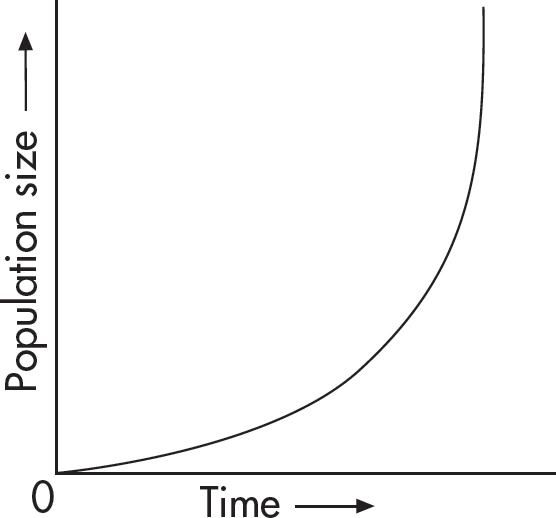
Exponential growth occurs very quickly, resulting in a J-shaped curve. A good example of exponential growth is the initial growth of bacteria in a culture. There’s plenty of room and food, so they multiply rapidly.
However, as the bacterial population increases, the individual bacteria begin to compete with each other for resources. When the resources become limited, the population reaches its carrying capacity, and the curve levels off.
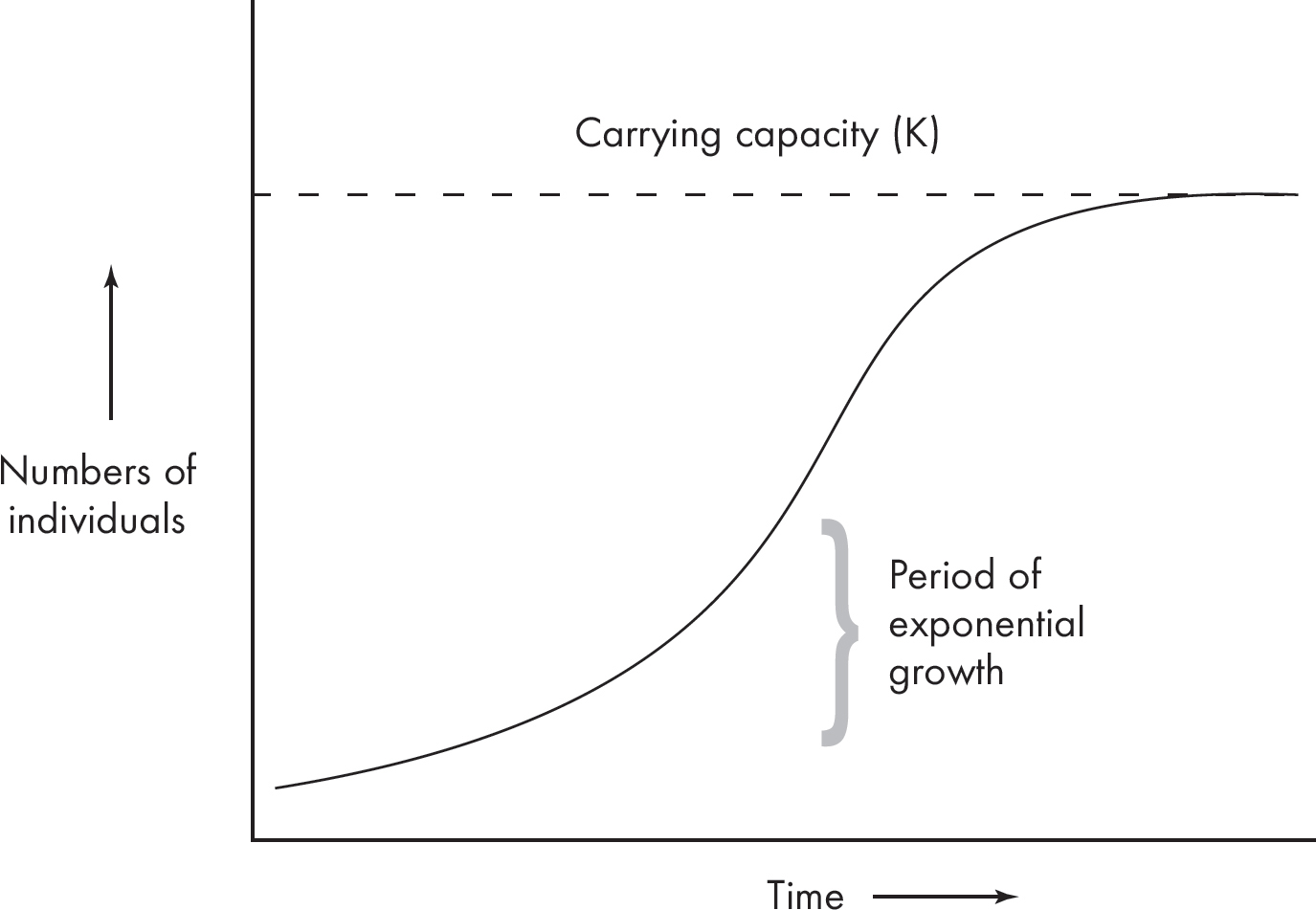
The population becomes restricted in size because of limited resources. This is referred to as logistic growth. Notice from the graph on the previous page that the growth forms an S-shaped curve.
These growth patterns are associated with two kinds of life-history strategies: r-selected species and k-selected species.
R-strategists tend to thrive in areas that are barren or uninhabited. Once they colonize an area, they reproduce as quickly as possible. Why? They know they’ve got to multiply before competitors arrive on the scene! The best way to ensure their survival is to produce lots of offspring. Typical examples are common weeds, dandelions, and bacteria.
At the other end of the spectrum are the k-strategists. These organisms are best suited for survival in stable environments. They tend to be large animals, such as elephants, with long lifespans. Unlike r-strategists, they produce few offspring. Given their size, k-strategists usually don’t have to contend with competition from other organisms.
Communities of organisms don’t just spring up on their own; they develop gradually over time. Ecological succession refers to the predictable procession of plant communities over a relatively short period of time (decades or centuries).
Centuries may not seem like a short time to us, but if you consider the enormous stretches of time over which evolution occurs, hundreds of thousands or even millions of years, you’ll see that it is pretty short.
The process of ecological succession in which no previous organisms have existed is called primary succession.
How does a new habitat full of bare rocks eventually turn into a forest? The first stage of the job usually falls to a community of lichens. Lichens are hardy organisms. They can invade an area, land on bare rocks, and erode the rock surface, over time turning it into soil. Lichens are considered pioneer organisms.
Once lichens have made an area more habitable, they’ve set the stage for other organisms to settle in. Communities establish themselves in an orderly fashion. Lichens are replaced by mosses and ferns, which in turn are replaced by tough grasses, then low shrubs, then evergreen trees, and, finally, deciduous trees. Why are lichens replaced? Because they can’t compete with the new plants for sunlight and minerals.
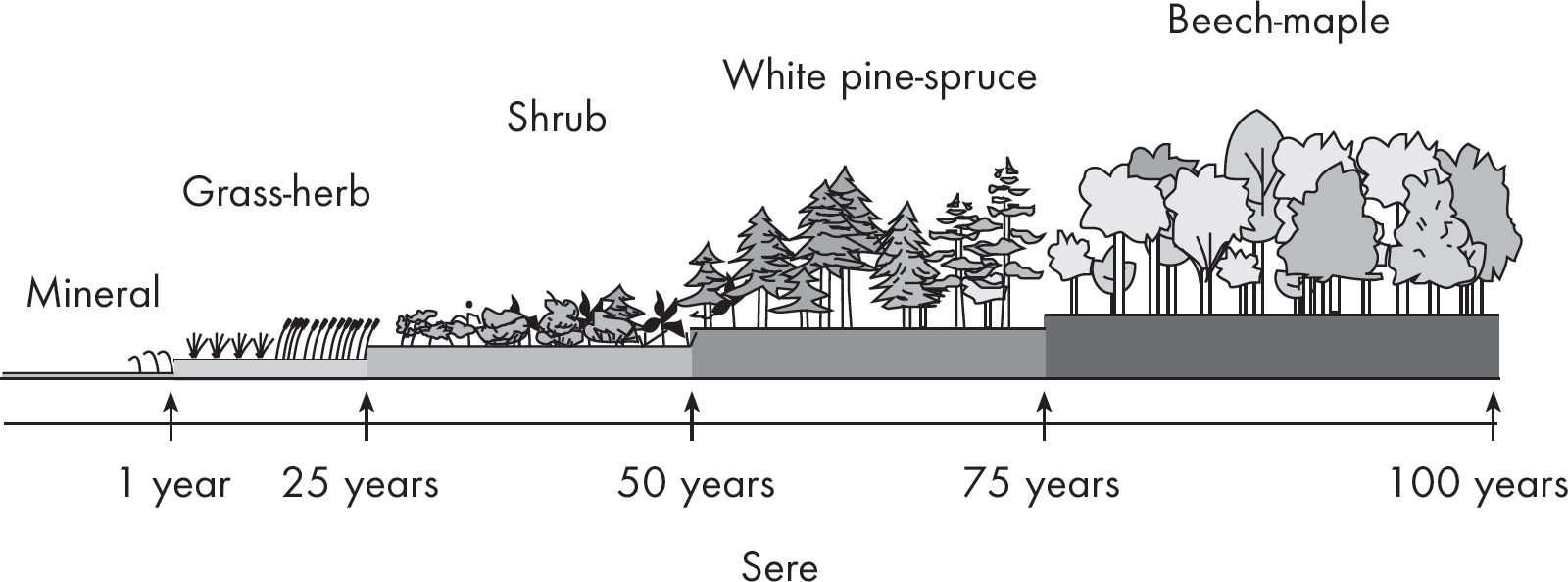
The entire sequence is called a sere. The final community is called the climax community. The climax community is the most stable. In our example, deciduous trees are part of the climax community.
Now what happens when a forest is devastated by fire? The same principles apply, but the events occur much more rapidly. The only exception is that the first invaders are usually not lichens, but grasses, shrubs, saplings, and weeds. When a new community develops where another community has been destroyed or disrupted, this event is called secondary succession. The existing community can be cleared by events such as fire, tornado, or human impact. These impacts leave soil intact, explaining how development occurs more rapidly.
Unfortunately, humans have disturbed the existing ecological balance, and the results are far-reaching. Soils have been eroded and various forms of pollution have increased. Potential consequences on the environment are summarized below.
Greenhouse effect: Atmospheric concentrations of carbon dioxide have increased by burning fossil fuels, and forests have contributed to warming of the earth. Higher temperatures may cause polar ice caps to melt and flooding to occur. Other potential effects of global warming include changes in precipitation patterns, changes in plant and animal populations, and detrimental changes in agriculture.
Ozone depletion: Pollution has also led to depletion of the atmospheric ozone layer by such chemicals as chlorofluorocarbons (CFCs), which are used in aerosol cans. Ozone (O3) forms when UV radiation reacts with O2. Ozone protects the earth’s surface from excessive ultraviolet radiation. Its loss could have major genetic effects and could increase incidence of cancer.
Acid rain: Burning fossil fuels produces pollutants such as sulfur dioxide and nitrogen dioxide. When these compounds react with droplets of atmospheric water in clouds, they form sulfuric and nitric acids, respectively. The rain that falls from these clouds is weakly acidic and is called acid rain. Acid rain lowers the pH of aquatic ecosystems and soil, which damages water systems, plants, and soil. For example, change in soil pH causes calcium and other nutrients to leach out, which damages plant roots and stunts their growth. Furthermore, useful microorganisms that release nutrients from decaying organic matter into the soil are also killed, resulting in fewer nutrients being available for the plants. Low pH also kills fish, especially those that have just hatched.
Desertification: When land is overgrazed by animals, it turns grasslands into deserts and reduces available habitats for organisms.
Deforestation: When forests are cleared (especially by the slash and burn method), erosion, floods, and changes in weather patterns can occur.
Pollution: Another environmental concern is toxic chemicals in our environment. One example is DDT, a pesticide used to control insects. DDT was overused at one time and later found to damage plants and animals worldwide. DDT is particularly harmful because it resists chemical breakdown, and it can still be found in tissues of nearly every living organism. The danger with toxins such as DDT is that as each trophic level consumes DDT, the substance becomes more concentrated by the process of biomagnification.
Reduction in biodiversity: As different habitats have been destroyed, many plants and animals have become extinct. Some of these plants could have provided us with medicines and products that may have been beneficial.
Introduction and Spread of Disease: Humans travel and disrupt habitats and bring diseases with them. These diseases can devastate all types of living things and act as immediate selective pressures, leaving the landscape of an ecosystem forever changed.
endotherms
ectotherms
behavior
instinct
learning
imprinting
critical period
habituation
circadian rhythms
pheromones
agonistic behavior
dominance hierarchy
territoriality
altruistic behavior
symbiotic relationship
mutualism
commensalism
parasitism
photoperiodism
tropism
phototropism
gravitropism
thigmotropism
auxins
gibberellins
cytokinins
ethylenes
abscisic acid
ecology
biosphere
ecosystem
community
population
biomes
biotic factors
abiotic factors
carbon cycle
niche
food chain
producers (autotrophs)
primary productivity
biomass
consumers (heterotrophs)
primary consumers
herbivores
secondary consumers
tertiary consumers
decomposer
keystone species
10% rule
ecological pyramid
bioaccumulation
biomagnification
Simpson’s Diversity Index
population growth
carrying capacity
population density
density-independent factors
density-dependent factors
exponential growth
logistic growth
r-strategists
k-strategists
ecological succession
primary succession
pioneer organisms
sere
climax community
secondary succession
greenhouse effect
ozone depletion
acid rain
desertification
deforestation
pollution
reduction in biodiversity
Behavior
Behavior is an organism’s response to the environment. Behavior can be instinctual (inborn), learned, or social:
Type of social behaviors include agonistic behavior, dominance hierarchies, territoriality, and altruistic behavior.
There are also plant-specific behaviors known as tropisms. The three basic tropisms are phototropism, gravitropism, and thigmotropism.
Ecology
There are several major biomes (tundra, taiga, temperate deciduous forest, grasslands, deserts, tropical rainforests) that make up the biosphere. Each biosphere contains ecosystems.
Within an ecosystem are communities, which consist of organisms fulfilling one of three main roles:
Producers, or autotrophs, convert light energy to chemical energy via photosynthesis.
Consumers, or heterotrophs, acquire energy from the things they consume. Their digestion of carbohydrates produces carbon, hydrogen, and oxygen, which are then used to make organic substances.
Decomposers form fossil fuels from the detritus of other organisms in the ecosystem.
The 10% rule says that only 10% of the energy consumed from one level will be retained by the higher level that consumed it. The other energy will be spent to perform normal daily activities.
The smallest unit of ecology is the population. The growth of a population can be found with the equation (r) = (births – deaths) / N.
The carrying capacity is the maximum number of individuals that can be supported by a habitat. Most populations do not reach carrying capacity due to factors such as population density (density-independent factors and density-dependent factors).
Exponential growth (J-shaped curve) occurs when a population is in an ideal environment. Logistic growth (S-shaped curve) of a population occurs when there are limited resources in an environment.
Organisms are generally either r-strategists or k-strategists. R-strategists ensure their survival by producing lots of offspring. K-strategists, which are usually large animals, produce few offspring but have longer life spans and less competition from other organisms for resources.
Succession describes the way in which ecosystems recover after a disturbance in terms of pioneers, sere, climax community, and secondary succession.
Human impact on the planet includes the following issues:
greenhouse effect
ozone depletion
acid rain
desertification
deforestation
pollution
reduction in biodiversity
introduction and spread of disease
Answers and explanations can be found in Chapter 15.
1. A chimpanzee stacks a series of boxes on top of one another to reach a bunch of bananas suspended from the ceiling. This is an example of which of the following behaviors?
(A) Operant learning
(B) Imprinting
(C) Instinct
(D) Insight
2. Viruses are obligate intracellular parasites, requiring their host cells for replication. Consequently, viruses generally attempt to reproduce as efficiently and quickly as possible in a host. Below is a graph depicting the initial growth pattern of a bacteriophage within a population of E. coli. This reproductive strategy is most similar to which of the following?

(A) An r-strategist, because it aims to produce a large abundance of offspring to ensure survival
(B) A k-strategist, because it aims to produce a large abundance of offspring to ensure survival
(C) An r-strategist, because it is best suited to thrive in stable environments and over a long life span
(D) A k-strategist, because it is best suited to thrive in stable environments and over a long life span
3. In a pond ecosystem, spring rains trigger an expansion of species at levels of the food chain. Runoff from nearby hills brings nutrients which, when combined with warming temperatures, trigger an algae bloom. The populations of small protozoans such as plankton expand by ingesting the algae. These plankton, subsequently, are consumed by small crustaceans such as crayfish, which ultimately become prey for fish such as catfish or carp. In this ecosystem, which of the following accurately describes the crayfish?
(A) They are producers.
(B) They are primary consumers.
(C) They are secondary consumers.
(D) They are tertiary consumers.
Questions 4–6 refer to the following table, chart, and paragraph.

Over the period of 1980 to 2000, the average pH in Richard Creek changed drastically. An ecological survey was performed to evaluate the effect of detectable decreases in pH on the aquatic life of the creek. Four times a year, ecological surveys were performed to identify the number of snails (a primary consumer), crayfish (a secondary consumer), and brook trout (a tertiary consumer) present at five different locations. The percent change relative to 1980 is shown in Chart 1 above. Many aquatic organisms cannot live in low pH conditions. The minimum pH necessary for common aquatic organisms to sustain life is shown in Table 1.
4. According to the data in Chart 1 and Table 1, the average pH in the creek is most nearly which of the following?
(A) 5.9
(B) 5.5
(C) 5.1
(D) 4.7
5. Which of the following is the most likely explanation for the abrupt decrease in pH in Richard Creek?
(A) Greenhouse effect
(B) Deforestation
(C) Acid rain
(D) Pollution
6. In order for snails to return to Richard Creek, the pH of the creek must exceed
(A) 5.4
(B) 5.7
(C) 6.0
(D) 6.1
7. Mimosa pudica is a plant often called the “sensitive plant” because when you touch the leaves, they immediately close up. One theory about the purpose of this type of movement is that herbivores avoid the plant due to this movement. The movement of Mimosa pudica is an example of
(A) phototropism
(B) gravitropism
(C) aquatropism
(D) thigmotropism

Question 8 refers to the following graph.
8. A proponent of the vegan diet writes a blog post that claims that the vegan diet is the only way to “reduce your carbon footprint, with respect to food, because it cuts your carbon footprint in half” and shows the graph above. Which of the following directly supports this claim?
(A) According to the 10% rule, only 10% of energy is passed from producers to consumers, so when humans consume animals, the energy harvested is greatly reduced.
(B) Livestock produce methane emissions and consume large amounts of plants every year.
(C) Deforestation for grazing livestock contributes to the loss of plants for carbon sequestration.
(D) Beef and lamb livestock—not chicken, fish, or pork—has the most dramatic impact on carbon footprint.
9. Costa Rica is plentiful with many beautiful tropical rainforests. For a long time, cattle farmers cleared much of the forests for their livestock. However, in recent decades, the government has placed more emphasis on reforestation. Several fields are now being reclaimed by the rainforest. One such field has many long grasses, a few tall palms, and some dense shrubbery along the periphery of the field. This field can be said to be
(A) invaded by pioneer species
(B) a product of secondary succession
(C) a climax community
(D) filled with invasive species
10. Probiotics are beneficial bacteria or yeast applied to maintain intestinal health in humans or livestock. In theory, these organisms inhabit the intestines and aid in digestion of food. Also, these organisms have bioprotective effects. How can addition of bacteria to the intestine protect the host from disease?
(A) Probiotic bacteria crowd the intestine, preventing pathogenic bacteria from growing due to density-dependent limitation on their population.
(B) Probiotic bacteria crowd the intestine, preparing a niche for pathogenic bacteria to grow.
(C) Bacteria populations grow exponentially until the carrying capacity is reached.
(D) Pathogenic bacteria do not recognize the intestinal cells because they are coated with probiotic bacteria.
Respond to the following questions:
Which topics from this chapter do you feel you have mastered?
Which content topics from this chapter do you feel you need to study more before you can answer multiple-choice questions correctly?
Which content topics from this chapter do you feel you need to study more before you can effectively compose a free response?
Was there any content that you need to ask your teacher or another person about?